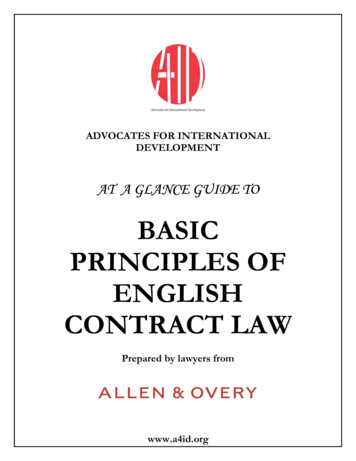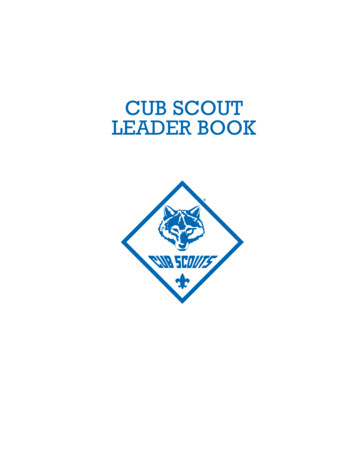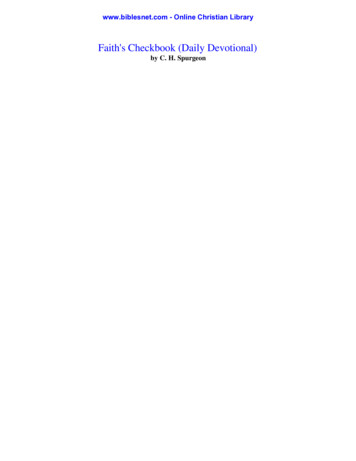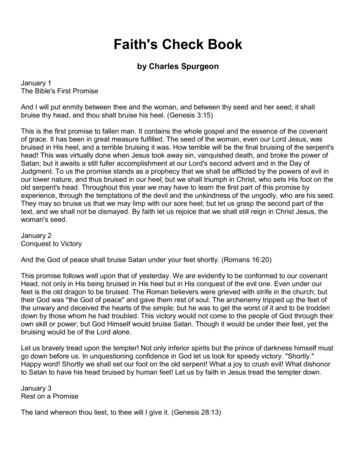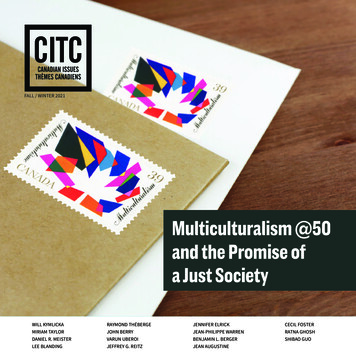
Transcription
FALL / WINTER 2021Multiculturalism @50and the Promise ofa Just SocietyWILL KYMLICKAMIRIAM TAYLORDANIEL R. MEISTERLEE BLANDINGRAYMOND THÉBERGEJOHN BERRYVARUN UBEROIJEFFREY G. REITZJENNIFER ELRICKJEAN-PHILIPPE WARRENBENJAMIN L. BERGERJEAN AUGUSTINECECIL FOSTERRATNA GHOSHSHIBAO GUO
TABLE OF CONTENTSINTRODUCTION3STRUCTURAL FAULT LINESMULTICULTURALISM @ 50: CHAINS OFTHE PAST AND DREAMS OF REBIRTH46OVERVIEW51Will Kymlicka7Miriam TaylorTHE MIDDLE-CLASS CHARACTER OF CANADIANMULTICULTURALISM AND ITS CONSEQUENCESJennifer ElrickGUY ROCHER, UNREPENTANT CRITIC OFCANADIAN MULTICULTURALISMJean-Philippe WarrenFOUNDATIONS58RELIGIOUS DIFFERENCE, LAW, ANDTHE SILENCES OF MULTICULTURALISM10HISTORICIZING MULTICULTURALISMDaniel R. MeisterBenjamin L. Berger15“A HARMONIOUS NATIONAL MOSAIC”?THE MULTICULTURALISM DEBATE OFTHE 1950S AND 1960SFUTURE IMPERATIVESLee Blanding21LET’S BE HONEST ABOUT MULTICULTURALISMAND OFFICIAL BILINGUALISM:PERSPECTIVES FROM THE COMMISSIONEROF OFFICIAL LANGUAGESRaymond Théberge65Jean Augustine70MULTICULTURAL IDEOLOGY33CANADIAN MULTICULTURALISM AND NATIONALIDENTITY – A 50-YEAR RELATIONSHIPJohn BerryVarun Uberoi39POPULAR MULTICULTURALISM AS SOCIALCAPITAL: TRENDS AND PROSPECTSJeffrey G. ReitzBEING BLACK: WATCHING MULTICULTURALCANADA GROW UPCecil Foster75PUBLIC CONSCIOUSNESS28MULTICULTURALISM AT 50:THE EXPERIENCE OF BLACK CANADIANSWHAT HAS MULTICULTURALISM ACHIEVEDIN CANADA AND WHAT ARE ITS CHALLENGES?Ratna Ghosh81MULTICULTURALISM AT A CROSSROADS:TOWARD PANDEMIC ANTI-RACISM EDUCATIONIN POST-COVID-19 CANADAShibao Guo
CANADIAN ISSUES IS PUBLISHED BYASSOCIATION FOR CANADIAN STUDIES BOARD OF DIRECTORSElected November 23, 2019DR. JULIE PERRONEChairperson of the Board of Directors, Director, Communicationsand Marketing, Finance Montréal, Montreal, QuebecCELINE COOPEREditor, The Canadian Encyclopedia, Instructor, Concordia University,Montreal, QuebecHUBERT LUSSIERRetired – Assistant Deputy Minister, Canadian Heritage, Ottawa,OntarioCanadian Issues is a biannual publication of the Associationfor Canadian Studies (ACS). Opinions expressed in articlesare those of the authors and do not necessarily reflect theopinion of the ACS. The Association for Canadian Studies isa voluntary non-profit organization. It seeks to expand anddisseminate knowledge about Canada through teaching,research and publications.Canadian Issues acknowledges the financial support of theGovernment of Canada through the Canada History Fund ofthe Department of Canadian Heritage for this project.JANE BADETSRetired – Assistant Chief Statistician, Statistics Canada, Ottawa,OntarioLETTERSGISÈLE YASMEENExecutive Director, Food Secure Canada, Montreal, QuebecComments on this edition of Canadian Issues?We want to hear from you!PROFESSOR HOWARD RAMOSDalhousie University, Halifax, Nova ScotiaCanadian Issues / ACS850-1980, rue Sherbrooke OuestMontréal, Québec H3H 1E8THE HONOURABLE MARLENE JENNINGSP.C., LLb.,Lawyer, Montreal, QuebecOr e-mail us at miriam.taylor@acs-aec.ca MADELINE ZINIAKConsultant, Chairperson of the Canadian Ethnic Media Association,Toronto, Ontario@CANADIANSTUDIESPROFESSOR CHEDLY BELKHODJAConcordia University, Montreal, QuebecJEAN TEILLETPartner at Pape Salter Teillet LLP, Vancouver, British ColumbiaPROFESSOR JOANNA ANNEKE RUMMENSRyerson University, Toronto, OntarioJACK JEDWABPublisherMIRIAM TAYLORLAURA COMBOÏGOTranslatorsAkash OndaatjeCopy-EditorMIRIAM TAYLORManaging EditorWILL KYMLICKAGuest EditorCAMILAHGO. STUDIO CRÉATIFDesign and Layout
INTRODUCTIONMULTICULTURALISM @ 50:CHAINS OF THE PAST AND DREAMS OF REBIRTHWILL KYMLICKAWill Kymlicka is the Canada Research Chair in Political Philosophy in the PhilosophyDepartment at Queen's University in Kingston, Canada, where he has taught since 1998.His research interests focus on issues of democracy and diversity, and in particular onmodels of citizenship and social justice within multicultural societies. He is co-director,with Irene Bloemraad, of a new CIFAR program on Boundaries, Membership andBelonging. He is also the co-director, along with Keith Banting, of the MulticulturalismPolicy Index project, which monitors the evolution of multiculturalism policies across theWestern democracies. Will's most recent work in this field focuses on issues of solidarityin multicultural societies.This year is the 50th anniversary of the adoptionof official multiculturalism in Canada, but it’s safeto say that most Canadians are not in a celebratorymood. After the discovery of 215 unmarked gravesat the Kamloops Indian Residential School in May2021, many towns and associations cancelledtheir “Canada Day” festivities, and Canadian flagson federal buildings were lowered to half-mast(and have remained that way), to honour andacknowledge the Indigenous victims of Canadiansettler colonialism. The powerful mobilization ofthe Black Lives Matter movement around issuesof systemic racism in Canada has reinforced theperception that this is a moment, not for celebration, but for sombre acknowledgement of our failings, and for re-evaluating our institutions, policies,and narratives, including our policies and narrativesof multiculturalism.historical soil from which“ Themulti-culturalism emerged, we mightsay, was not propitious for a trulyinclusive and emancipatory policy,and Canadians are continuing to livewith the consequences.”The papers in this issue of Canadian Issues providesome historical context for this moment. Several ofthe authors argue that the limits and shortcomingsof multiculturalism are not failures of implementation or communication or funding, but rather havedeeper historical roots. The conception of multiculturalism adopted in 1971 was rooted in the prevailing ideologies and power structures of the time,3
MULTICULTURALISM @ 50: CHAINS OF THE PAST AND DREAMS OF REBIRTH - WILL KYMLICKAand so has ended up reproducing many of theselong-standing hierarchies and exclusions. Thehistorical soil from which multiculturalism emerged,we might say, was not propitious for a truly inclusiveand emancipatory policy, and Canadians arecontinuing to live with the consequences.Each of the authors focuses on somewhat different aspects of this historical soil, and on differentdimensions of the ideologies and power structuresat play in the lead-up to the adoption of the policy.For some authors, the crucial ideology and powerstructure is colonialism: multiculturalism encouraged ethnic groups to align themselves with settlersociety (English or French), and thereby recruitedthem into the ongoing project of dispossession ofIndigenous peoples (Foster; Blanding). For otherauthors, the crucial ideology and power structureis racism: ideas of multiculturalism emerged fromthe same toxic stew that included ideas of eugenicsand racial hierarchy, consolidating a sense of whiteprivilege amongst English, French and white ethnicgroups, while relegating nonwhites to the margins(Meister, Augustine, Guo). For yet others, the crucialideology and power structure is class: multiculturalism emerged as part of a project of buildinga society around middle-class traits of “ambition,dependability, self-reliance, discipline, perseverance, and self-mastery”, while relegating ‘nonproductive’ immigrants (and native-born) to themargins (Elrick). Others suggest the crucial ideologyand power structure is secular liberal legalism:multiculturalism has operated to consolidate thepower and legitimacy of the liberal state, andhence marginalizes non-liberal religious groups14that dispute the right of the state to govern all ofsociety (Berger). And finally, there is the longstanding critique that multiculturalism reflects andperpetuates the power imbalance between Frenchand English, drowning the Quebecois nation in themulticultural sea of Anglophone North America(Warren).1These are all important insights into the roots ofmulticulturalism, and while the authors focus ondistinct aspects, they are in many ways complementary analyses. After all, ideas of race, class andculture are all intertwined in practice, and justifications for power hierarchies often move subtlybetween these different registers. Each of thesepapers can be seen as capturing one dimension of acomplicated web of ideologies and hierarchies thatstructure Canadian society and politics.So, the papers in this issue help to explain why,fifty years after the adoption of multiculturalism,we remain very far from the ‘just society’ that multiculturalism seemed to promise (Ghosh). However,in solving one puzzle, these papers arguably raiseanother puzzle: namely, why has multiculturalismremained so popular in Canada? According tomany of the analyses in this issue, multiculturalismhas operated to uphold and exalt the white secular liberal English-speaking settler middle-class,and so it is perhaps not surprising that individualsin this group endorse multiculturalism. But theevidence suggests that support for multiculturalismin Canada is much wider than this. In his paper,Varun Uberoi cites some of the survey evidencethat shows surprisingly high and stable support forSee Raymond Théberge for an alternative interpretation of how multiculturalism relates to the French fact in Canada.
MULTICULTURALISM @ 50: CHAINS OF THE PAST AND DREAMS OF REBIRTH - WILL KYMLICKAmulticulturalism in the general Canadian population, including amongst minorities.In fact, support for multiculturalism can be foundin some surprising places. One particularly strikingexample is a recent study of attitudes towardsmulticulturalism amongst prisoners in provincialjails in Alberta.2 This population is heavily racialized and economically disadvantaged, very distantfrom the white middle-class whose values andpower are said to underpin multiculturalism. Yet itappears that they too have internalized the multicultural ethos. This is just one of many exampleswhere critical social scientists in Canada have gonelooking for those who are said to be excluded orbanished from multiculturalism, only to discoverthat members of these groups often express genuineappreciation, even gratitude, for multiculturalism.While critical academic theories tell us that multiculturalism stigmatizes and disempowers certaingroups, surveys and interviews with the membersof these groups often suggest that they feel empowered and respected by multiculturalism.3In my view, this is an equally important part of the50-year history of multiculturalism in Canada, andone which requires explanation. What is it that somany Canadians – across various racial, religiousand class divides – see in multiculturalism? Andhere the papers by Jeff Reitz, Varun Uberoi andJohn Berry are helpful, identifying both sociological and psychological factors at play. At a sociological level, multiculturalism can enhance “socialcapital”: it helps to facilitate trust and cooperation.At a psychological level, multiculturalism may helpto meet some basic human needs and motivations.It seems that for many people, multiculturalismfacilitates a sense of belonging, one that operatesin two directions: people feel a sense of belongingto the larger society, but also that the society belongsto them, and hence that they have a right to a say, aright to complain, a right to refashion society.It is not easy to know how to reconcile this popularsentiment with more critical academic analyseswhich suggest that multiculturalism was neverintended to give certain groups the right to remodelthe house we call Canada. It seems that multiculturalism has slipped anchor from its moorings, andthat many Canadians see in multiculturalism something more than, or other than, the sum of its historical sources. They see multicultural futures that arenot destined to reproduce the prevailing hierarchiesand ideologies of its origins fifty years ago.in 2021 are living through“ Canadiansa particularly vivid moment of this“unhappy consciousness”, tornbetween aspirations for rebirthand the chains of the past.”Of course, this may be naïve. And Canada will neverachieve these multicultural futures unless we make2Tetrault, Justin EC, Sandra M. Bucerius, and Kevin D. Haggerty. "Multiculturalism under confinement: Prisoner race relations inside western Canadianprisons." Sociology 54.3 (2020): 534-5553To cite just one other example, see Iqbal, Maleeha, Laila Omar, and Neda Maghbouleh. "The Fragile Obligation: Gratitude, Discontent, and Dissent withSyrian Refugees in Canada." Mashriq & Mahjar: Journal of Middle East and North African Migration Studies 8/2 (2021): 1-30.5
MULTICULTURALISM @ 50: CHAINS OF THE PAST AND DREAMS OF REBIRTH - WILL KYMLICKAan honest reckoning with the past. Foster capturesthis dynamic when he writes:multicultural Canada began life like an orphan. Ithad some idea of an ancestral history that especiallydominant Canadians–or some of them–wantedto retain and even preserve. Truly an unhappyconsciousness, it was like the modern individualuncertain of how much this heritage was preparingit for a new life on its own, that could only occurthrough a mythological rebirth, or of how much ofthis legacy was like those chains every Scrooge individually was destined to drag into the future unlessthere is a fundamental and honest recounting andrecanting of past deeds.Canadians in 2021 are living through a particularlyvivid moment of this “unhappy consciousness”,torn between aspirations for rebirth and the chainsof the past. Several of the articles in this issuehelp to identify why indeed multiculturalism is soanchored to the past, but there are also glimpsesof why and how multiculturalism can be part of abetter future.6
OVERVIEWMIRIAM TAYLORMiriam Taylor is the Director of Publications and Partnerships at the Associationfor Canadian Studies and Metropolis Institute.Entitled Multiculturalism @ 50 and the Promise of aJust Society, this special edition of Canadian Issues,explores the roots, characteristics and structuralfault lines of Canadian multiculturalism and outlinesthe reframing required if the policy hopes to live upto its initial promise of delivering a just society. Inhis introduction, guest editor and eminent politicalphilosopher Will Kymlicka reflects on the insightsof contributing authors some of whom trace multiculturalism’s failings back to its very foundations,but who also offer “glimpses” of why and howmulticulturalism might aspire to rebirth and offera “better future”.The issue is divided into four sections: (1) Foundations, (2) Public Consciousness, (3) Structural FaultLines and (4) Future Imperatives.Section (1), Foundations, opens with an articleby Daniel Meister, who places multiculturalismin its historical context, tracing its social, politicaland cultural roots to a pluralism infected by racistand settler colonialist ideologies that effectivelyexcluded nonwhites. The decades preceding theofficial implementation of multiculturalism are alsothe focus of Lee Blanding’s article, who questionswhether, having failed to include the voices of keystakeholders including Indigenous peoples, theprevailing multiculturalist discourse can respondto the pressing needs of an “age of Reconciliation”. In an article making a case for the complementarity of multicultural policy and officialbilingualism, Commissioner of Official LanguagesRaymond Théberge depicts the often-overlookeddiversity within Canada’s Francophone populationand maintains that Canada’s bilingual frameworkenhances rather than detracts from diversity withinthe country.In (2) Public Consciousness, John Berry sees “widespread acceptance of diversity” as fundamental tothe success of multicultural policy and describesefforts to measure this prevalent “multiculturalideology” by means of an “intercultural scale” both7
OVERVIEW - MIRIAM TAYLORin Canada and internationally. While concedingthat it is no simple feat to prove the impact onnational unity of fifty years of multicultural policy,Varun Uberoi argues that it has been “effective atencouraging inclusive forms of national identity”,given that a majority of Canadians identify multiculturalism as a “national symbol and an importantfeature of how they conceive of Canada.” JeffreyReitz also explores the meaning of multiculturalismfor Canadians and the role it has played in building“social capital”, pointing out, however, that strongsupport for multiculturalism has not led to morewillingness to tackle equity issues thus hamperingthe country’s ability to address the underlyingproblems created by racism and discrimination.In (3) Structural Fault Lines, four authors expoundon the ways in which the very structure of multiculturalist policy either violates its own principles or is ill-equipped to meet the imperatives of adiverse society that aspires to equity and solidarity.In its promotion of a multicultural citizenship thatlimits full membership to “individuals who displaymiddle-class traits and/or demonstrate economicutility,” Jennifer Elrick argues that multiculturalpolicy is possibly contravening its stated idealsand contributing to a decline in social solidarity.In his exposé of the views of an unrepentant criticof multiculturalism, Jean-Philippe Warren placessociologist Guy Rocher’s objections to multiculturalism in the tradition of those who view the policyas a betrayal of the bilingual two-pillared conception of Canadian Confederation. In “Silences ofMulticulturalism”, Benjamin Berger sheds light onthe failure of the liberal constitutional system tolive up to its claims to autonomy and universality,showing up the law’s incapacity to act as objectivearbiter on fundamental issues of religious freedom,8particularly in the case of “religious groups thatdiverge significantly from the metaphysical andnormative mainstream.”The final section, (4) Future Imperatives, looksahead to sketch the reframing, rebuilding andreeducating required to institute a multiculturalism inclusive of all Canadians. While remainingsteadfast in her commitment to a policy that shehelped develop and launch, former Multiculturalism Minister, Jean Augustine, is uncompromising in her call for a “reframing of multiculturalism,within an anti-racist and anti-oppression spacethat intentionally seeks to dismantle the systemicharms of white privilege.” Cecil Foster also exposesthe structural racism and exclusion built into thefoundations of multiculturalism and calls forthe courage to abandon old power structures to awell-deserved grave in favour of a “genuine multiculturalism – where power, belonging and entitlement start through individual recognition but thatindividuals can subsequently choose to be countedby ethnicity, racialization, gender, place of birth orany other social category that speaks to diversityand inclusiveness.” While multiculturalism originally promised a reversal of assimilationist tendencies, Ratna Ghosh argues that its static focus onheritage cultures and language has blinded it to itsperpetuation of structural inequalities, a challengewhose urgency has become all the more apparent in the present context. In his article, ShibaoGuo describes how the COVID-19 pandemic hascontributed to the propagation throughout thecountry of an anti-Asian virus fuelled racism andhatred, exposing the need for “critical deep reflections on the rhetoric of Canadian exceptionalism”and for the establishment of a comprehensive antiracist education program.
FOUNDATIONS
HISTORICIZING MULTICULTURALISMDANIEL R. MEISTERDaniel R. Meister is an independent scholar with a PhD in Canadian History. He hastaught at Queen’s University, held a Lillian Agnes Jones Fellowship at the WhyteMuseum of the Canadian Rockies, and worked as a Researcher at the Canadian Museumof Immigration at Pier 21. His book, The Racial Mosaic: A Pre-History of CanadianMulticulturalism, is published by McGill-Queen’s University Press this fall.What on earth is historicizing and why shouldmulticulturalism be subjected to it? Historicize isa somewhat uncommon word that simply meansto treat something as historical, to place it in itshistorical context. Historicizing is not synonymouswith celebrating, criticizing, or even debating – andmulticulturalism has already endured more thanenough of all that, with no end in sight. Indeed,the study of multiculturalism in Canada is a rathercurious subfield if it can even be called that. Typing“multiculturalism” into an academic search enginetriggers an avalanche of results from a host ofdisciplines with no apparent unifying theme.However, much of this scholarship engages with110a debate initiated by political philosophers aboutthe place of multiculturalism in liberal politicaltheory. These debates have been as vigorous asthey have been voluminous. But it is important tonote that this theorizing has all been done after thefact. Despite what some have argued, the Canadianpolicy of multiculturalism was not based on anypre-existing formal political theory or philosophyby that name.Turning away from the theoretical, it becomesobvious that little of the policy’s history has beentraced, leaving important questions, such aswhy and how Canada came to have this policy,completely unanswered.1 Although fifty years haveConsider, as a prime example of the paucity of literature on the subject, that one of the few works on the history of multiculturalism consistently cited by leadingtheorist Will Kymlicka is an unpublished thesis dating from the 1970s. Will Kymlicka, “The Canadian Model of Multiculturalism in a Comparative Perspective,”in Multiculturalism and the Canadian Constitution, ed. Stephen Tierney (Vancouver: UBC Press, 2007), 87n23.
HISTORICIZING MULTICULTURALISM - DANIEL R. MEISTERelapsed, we still have no clear understanding of whyPrime Minister Pierre Elliott Trudeau introducedthe policy of multiculturalism in 1971. Given thatreality, I can’t help but argue that a bit of historicizing is in order (although I recognize it is terriblycliché for a historian, when asked to think about thefuture, to call for a closer examination of the past).study of multiculturalism is further“ Theconfused by how the term itself can bedefined in many different ways. It istypically used in one of three senses:sociological, ideological, or political.”It is well documented that, after being introduced inCanada, multiculturalism become an internationalphenomenon, with several nations adopting policies with that name, and others using the term toapply to various policies and practices relating toimmigration and diversity more generally. In theseother, predominantly European, countries there hassince been a backlash against multiculturalism andrepeated statements from European political leaders that the policy has “failed.”2 In Canada, however,multiculturalism continues to enjoy wide supportfrom the public and all major political parties and infact has become integral to national identity.3 Thenational importance of this public policy makes itall the more surprising that its history has not yetbeen adequately traced.The study of multiculturalism is further confusedby how the term itself can be defined in manydifferent ways. It is typically used in one of threesenses: sociological, ideological, or political. That is,it can refer to the fact of human diversity, the ideathat multiple cultures can (and perhaps should)peacefully coexist within a single nation, or to agovernment policy. As sociologist Richard Daypersuasively demonstrated over two decades ago,many people, including Canadian governmentofficials, have blurred definitions, suggesting thatCanada has always been both sociologically andideologically multicultural, and therefore that thepolicy was a natural progression or an outgrowth ofthis specific history.4should not imagine that it was“ Weinevitable for Canada to have a policyof multiculturalism, regardless of thecountry’s sociological diversity.”This is, of course, untrue. When thinking aboutmulticulturalism as an ideology, it is importantto heed historian and theorist Quentin Skinner’s2See for instance Steven Vertovec and Susanna Wessendorf, eds., The Multiculturalism Backlash: European Discourses, Policies, and Practices (London andNew York: Routledge, 2010).3According to a 2015 report by the Environics Institute, “multiculturalism continues to be seen as one of the country’s most important symbols, and this viewhas strengthened since 2010.” Over half of Canadians identified it as an important symbol, placing it above the Queen, the RCMP, and even hockey. Seetheir Canadian Public Opinion About Immigration and Multiculturalism (Spring 2015), 1 and 2.4Richard J.F. Day, Multiculturalism and the History of Canadian Diversity (Toronto: University of Toronto Press, 2000), 6.11
HISTORICIZING MULTICULTURALISM - DANIEL R. MEISTERwarning that intellectual historians should notimagine that a philosophy was somehow “alwaysimmanent in history.”5 That is, we should notimagine that it was inevitable for Canada to have apolicy of multiculturalism, regardless of the country’s sociological diversity. In other words, weshould not go back through history, eagerly seeking out people and their writings which supposedly‘anticipate’ the policy. We should instead examine the history of Canadian policies and practicesrelating to culture and immigration, tracing theirevolution over time, and seeking to understand thesocial, political, and cultural conditions that madeit possible – and even expedient – for such a policyto be announced.Most existing attempts to provide a thumbnailsketch of the policy begin with Prime MinisterPierre Elliott Trudeau’s statement in the House ofCommons in 1971, one of the few times he spokeabout the policy and certainly the lengthiest. Init, he explained that it was a policy of culture, notof immigration. Though its purpose was scantilydefined, the policy was intended to support andencourage cultural and ethnic groups to “sharetheir cultural expression and values with otherCanadians.”6 For most of Canadian history upuntil that point, policies and practices relating toculture and integration were rooted in the beliefthat peoples of non-British, non-French Europeandescent should assimilate, that is, abandon theirrespective cultures and adopt Anglo-Canadianculture as their own. While Trudeau may not havepresented it as such, multiculturalism was clearly a12break with these past policies and practices, whichmakes understanding this context crucial to anyaccount of the policy’s history. And while Trudeauinsisted that the policy of multiculturalism was notone of immigration, immigration policies dictatedwhat cultural and ethnic groups were allowedinto Canada to share their “cultural expressionsand values” in the first place. Therefore, the history of multiculturalism must also be placed withinthe context of the history of policies and practicesrelating to Canadian immigration.The groundbreaking work done by historianHoward Palmer in the 1970s and ‘80s provides avaluable overview of this historical context. In animportant essay presented to the Second CanadianConference on Multiculturalism (1976), Palmerexamined what he called three Anglo-Canadiantheories of assimilation. The first, Anglo-conformity, demanded immigrants adopt the behaviour andvalues of Anglo-Canadians and was predominantbetween 1867 and 1920. It then fell into disreputeand was replaced by the ‘melting pot’ theory, whichemerged during the 1920s and suggested thatthe blending of immigrant cultures would createa new Canadian culture. Palmer argued that a“third theory of assimilation – ‘cultural pluralism’or ‘multiculturalism’” was vying for public acceptance by the 1960s and into the 1970s. This viewdeveloped after the Second World War and recommended that some aspects of immigrants’ culturebe preserved “within the context of Canadiancitizenship and political and economic integrationinto Canadian society.” However, Palmer suggested5Quentin Skinner, “Meaning and Understanding in the History of Ideas,” History and Theory 8, no. 1 (1969): 3–53, quote at 10.6House of Commons, Debates (8 October 1971), 8545.
HISTORICIZING MULTICULTURALISM - DANIEL R. MEISTERthat the earliest expressions of “full-blown pluralist ideas” came much earlier, in the 1930s, inthe writings of John Murray Gibbon (a publicistwith the Canadian Pacific Railway) and WatsonKirkconnell (a professor and translator of so-callednew Canadian poetry).7early expressions of cultural“ thesepluralism were limited by scientificracism and rooted in settler colonialism,with the result that the only culturesthat these men considered worthy ofretention and celebration were thoseof Europeans.”In my forthcoming book, The Racial Mosaic, Ihave studied this period more closely. Taking abiographical approach, I examined the lives andthought of Gibbon and Kirkconnell, as well asone of their peers, Robert England (an administrator with the Canadian National Railways).8 Allthree of these men expressed what I have calledphilosophies of cultural pluralism, however, theirphilosophies were crafted at particular times andexpressed in particular works, each of which hadtheir own unique purposes. Many of their callsfor the acceptance of non-British, non-French,European cultures in Canada came in the contextof the interwar increase in immigration and theheated debate over the suitability of these immigrants, especially Ukrainians. But their callsfor acceptance were limited in important ways,shaped as they were by notions of race, racism, andeugenics. More specifically, these early expressionsof cultural pluralism were limited by scientific racismand rooted in settler colonialism, with the resultthat the only cultures that these men consideredworthy of retention and celebration were thoseof Europeans. All those racialized as non-white,such as people of African, Asian, and Indigenousdescent, were excluded from the pluralistic Canadathey imagined, which they described using variousphrases and metaphors, such as tapestry, kaleidoscope, garden, and – most famously – mosaic.It remains unclear of the degree to which officialmulticulturalism at the time of its announcementdif
and power structure is secular liberal legalism: multiculturalism has operated to consolidate the power and legitimacy of the liberal state, and hence marginalizes non-liberal religious groups that dispute the right of the state to govern all of society (Berger). And finally, there is the l


